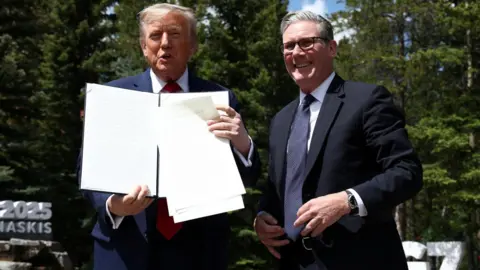In a recent article by political editor Chris Mason, the narrative surrounding the tariffs deal struck between the US and the UK, primarily involving President Donald Trump and British Prime Minister Sir Keir Starmer, reaches into the depths of diplomacy shaped by political theatrics. The backdrop of this story is set against the picturesque Canadian Rockies, where the G7 summit convened, bringing global leaders together to address pressing international issues, including trade.
The article starts with a vivid description of President Trump emerging from his discussions with Starmer, maneuvering a folder that allegedly contained the crucial tariffs agreement. Mason paints the scene with a touch of drama, recounting how, in a moment of slapstick, Trump’s documents scattered wildly onto the tarmac, with Starmer hastily bending down to retrieve them. This amusing yet telling moment serves to highlight the sometimes chaotic nature of political negotiations, especially in the presence of such a flamboyant character as President Trump.
Mason delves into the specifics of the tariffs deal itself, indicating that while it represents a significant accomplishment for Downing Street, it is crucial to identify its limitations. Under the new agreement, the aerospace sector in the UK would benefit from the removal of all tariffs, while a 10% tariff would be levied on the automotive industry. This is particularly important news for manufacturers like Jaguar Land Rover, with Starmer having made two recent visits to their Solihull plant in response to previous concerns regarding tariffs that could lead to job losses in the region.
It is clear that this deal is poised to assuage fears among the British government and businesses regarding the potential ramifications of tariffs on employment. However, Mason notes an important caveat in the discussion of the tariffs—while the UK is currently granted an exemption from the global 50% tariffs on steel and aluminum, a 25% tariff remains applicable. Ongoing negotiations aim to eliminate this tariff, but complicated issues around demonstrating the origin of the steel present key obstacles, revealing the intricate details involved in international trade agreements.
Apart from the tariff discussions, the deal allows for reciprocal access to 13,000 metric tonnes of beef traded between the US and the UK, facilitating British farmers’ export opportunities. Crucially, government officials assure that there have been no alterations to the UK’s food safety standards, reinforcing a point often surrounded by skepticism during trade negotiations.
As Mason highlights, this agreement does not embody the comprehensive US-UK trade deal that many had once envisioned, nor is it devoid of the peculiar unpredictability associated with negotiations led by President Trump. Despite these elements, the deal serves as a noteworthy achievement for Prime Minister Starmer on the global stage, particularly amid growing challenges back home.
Mason wraps up his assessment by reiterating the balance of triumph and caution for the British government. The newfound tariffs deal allows Starmer to walk away with a notable feather in his cap, yet it stands as a stark reminder of the complexities and complications inherent in international diplomacy. The spectacle of the G7 summit, complete with its high stakes and dramatic moments, serves not merely as a backdrop but as an insightful lens into the ongoing saga of trade relations between historic allies.
In conclusion, while the tariffs deal marks progress for the UK government, it is essential to approach the evolving landscape of international relations with a discerning eye, recognizing both achievements and remaining challenges in global trade dynamics.



